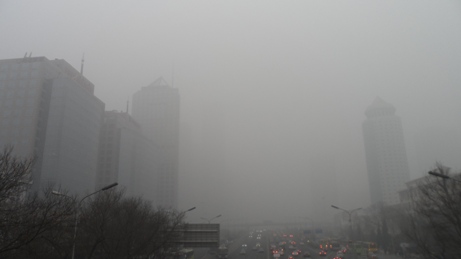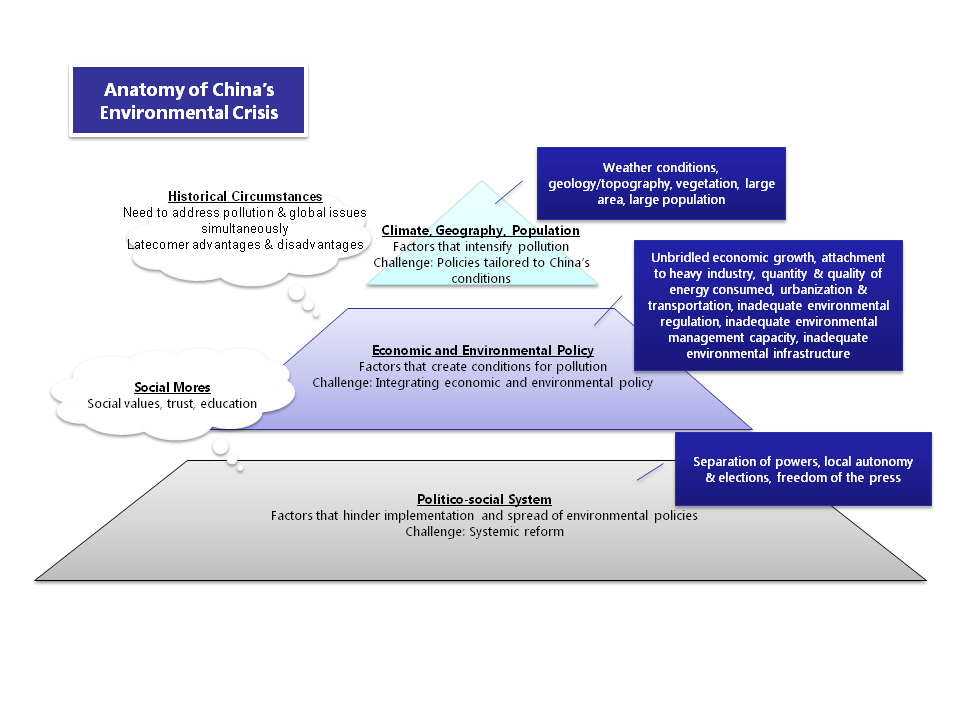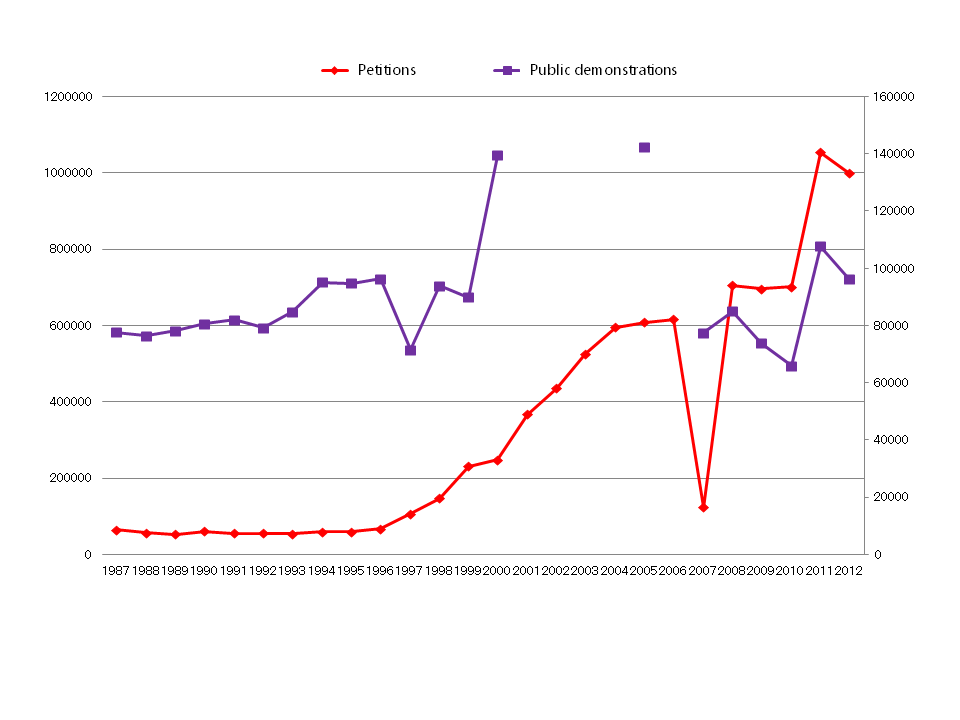- Article
- Chinese Economy
Breathing the Same Air: Outlook for Environmental Change in China
February 5, 2014
The suffocating cloud of smog in Beijing and other Chinese cities have triggered public outrage and unprecedented soul-searching at the highest levels of Chinese government. But it will take more than a few protests and government directives to change the way the Chinese do business. Research Fellow Kenji Someno assesses the outlook for meaningful change.
* * *
Air pollution is a serious and growing problem all over China. The basic culprits are skyrocketing consumption of fossil fuels, particularly coal, to power a rapidly developing and expanding economy; the widespread use of low-quality fuel with high sulfur content; and lax policies to control pollution from factories, power plants, and motor vehicles. The smog crisis of January 2013, when air quality plunged to dangerous levels in Beijing and elsewhere, occasioned public soul-searching by Chinese officials and provided strong evidence that China’s current pace and style of economic growth is unsustainable environmentally as well as demographically. The situation, moreover, has not improved one year later. In the following, I review the basic factors underlying the crisis and their implications for China’s environmental future.
Dark Days in Beijing
On January 10, 2013, a thick cloud of smog formed over much of north and central China. Although Beijing was hit the hardest, the noxious haze enveloped much of Hebei, Henan, Shandong, Jiangsu, Anhui, Shaanxi, and even Sichuan province. Altogether, it covered an area measuring 1.4 million square kilometers—about one-seventh the total land area of China and approximately 3.5 times that of Japan.

One particularly dangerous component of the dense smog that grabbed world headlines last January was particulate matter: tiny airborne particles that can cause serious respiratory problems. On January 12 and 13, many pollution monitoring stations in Beijing were recording levels of PM 2.5—particles measuring less than 2.5 microns—in excess of 700 microns per cubic meter. At 11:00 pm on January 12, multiple monitoring stations recorded PM 10 (particles between 2.5 and 10 microns) levels surpassing 900 μg/m 3 , while readings at the Xizhimen station hit 993 μg/m 3 , the highest concentration on record.
The Beijing Municipal Bureau of Environmental Protection blamed the episode on weather conditions and unusually high levels of atmospheric emissions, compounded by chronic air pollution in the area. It seems that the unusually cold weather gripping Beijing since the previous December had caused a spike in coal consumption for heating, adding to emissions from vehicles, factories, and power plants inside and around the city. At the same time, a temperature inversion, in which air at ground level is colder than the air above it, prevented the pollution from dissipating, pushing up levels to dangerous levels over a wide area.
But a distinction needs to be drawn between the temporary conditions that precipitated the episode and the ongoing factors that made the region vulnerable to such a crisis in the first place. At a press conference held on March 15, 2013, during the annual spring session of the National People’s Congress, Vice Minister of Environmental Protection Wu Xiaoqing blamed the event on underlying environmental problems that have built up as a result of rapid industrialization and urbanization.
He noted that China’s three major metropolitan areas—the Beijing-Tianjin-Hebei region, the Yangtze River delta (including Shanghai), and the Pearl River delta (including Guangzhou)—which together make up only 8% of China’s total land area, account for 42% of the nation’s coal consumption and 52% of its gasoline consumption, as well as 55% of its steel production and 40% of cement production. As a consequence, their emissions of sulfur dioxide, nitrogen oxides, and particle pollution per unit area is about five times higher than the rest of the country, accounting for some 30% of atmospheric emissions nationwide.
Wu added that smog reached serious levels at least 100 days out of the year in these areas, with some cities recording more than 200 smoggy days per year.
Getting to the Root of the Problem
As the foregoing suggests, although weather conditions precipitated the crisis, the stage had been set earlier by excessive emissions of atmospheric pollutants. Pursuing the chain of cause and effect to its source, we can see how a failure of policy allowed economic growth and pollution to spiral out of control, and further, how this policy failure reflects flaws in China’s social and political system (see figure below).
Most people agree that China’s ongoing pollution problem is a product of the unbridled economic growth of the past two decades. The issue here is not just the scale of the economy and the speed of its growth. It is also a stubbornly inefficient economic structure that consumes vast amounts of energy in the creation of wealth. At heart, this is a policy issue. China needs to shift its economic emphasis away from energy-intensive heavy industries if it is to achieve sustainable growth.
A related issue is the kind of fuel China uses to power its economy. The continued reliance on coal is a major problem in itself, but so is the low quality of the fossil fuels people use to run their vehicles, heat their homes, and so forth. For example, the maximum sulfur content for automobile fuel under the “China III” standards still applied in most parts of the country is some 15 times higher than the limit enforced in most industrialized countries. With such fuel, even vehicles meeting today’s tough environmental standards will be unable to achieve clean emissions.
The rapid pace of urbanization is another oft-cited factor. China’s top officials have continued to stress urbanization as a key strategy for modernization. Yet when cities grow so fast that the transportation system is unable to keep pace, as in Beijing, the number of automobiles skyrockets, and air pollution inevitably worsens.
All of this points to a failure of environmental policy despite a long history of government involvement in environmental initiatives. In 1972, Chinese representatives attended the first United Nations Conference on the Human Environment in Stockholm, and China held its first National Environmental Protection Conference the following year. The 1978 constitutional revision added a new article stating, “The state protects and improves the living environment and the ecological environment, and prevents and controls pollution and other public hazards.” The Environmental Protection Law was adopted provisionally in 1979, followed by a series of laws covering various aspects of the environment.
Unfortunately, the development of environmental infrastructure and the enforcement of regulations have not matched China’s policymaking fervor. Chinese environmental agencies are understaffed and underfunded. The Ministry of Environmental Protection has a full-time staff of about 350. Even allowing for differences in jurisdiction, this seems sadly inadequate when compared with the size of Japan’s Ministry of the Environment (1,500 employees) or the US Environmental Protection Agency (18,000 employees)—particularly in view of China’s huge population and land area.
China’s environmental expenditures have grown substantially over the past few years and now approach 3% of gross domestic product. But this level of investment is still far short of the estimated 8.5% of GDP that Japan spent controlling pollution in the 1970s. By China’s own estimates, it will need to spend at least 7% of GDP to get pollution under control (see No ‘Shortcuts’ with Environmental Action by the author).
A Systemic Failure
How, then, do we account for China’s failure to implement effective environmental policies?
The most fundamental problem of all is China’s politico-social system. China may adopt green technologies and strengthen environmental regulations, but in the absence of social and political mechanisms for accountability, these efforts are bound to remain piecemeal and transient in their effect, instead of bringing about widespread and fundamental improvement.
The history of environmental policy in Japan may be instructive in this regard. One key to progress is the constitutional separation of powers. Thanks to an independent judiciary, citizens had recourse to the courts when the government’s response fell short. Another key is local autonomy and democratically elected local executives. In Japan, it was local politicians—directly accountable to the voters and responsible for their welfare—who took the first steps toward controlling pollution. The third key is a free and independent press that monitors the situation and informs the public of problems, infractions, and conflicts of interest. In short, Japan has been able to bring economic and environmental policy into balance thanks to three essential elements of our democratic system: separation of powers, local autonomy and elections, and freedom of the press.
Of course, China must choose its own system of government. But the need for mechanisms that function more or less as those discussed above is becoming increasingly apparent. If society rewards cheating and evasion rather than compliance and cooperation, it will not doubt be hard to protect the environment from degradation, even with access to the most advanced technology.
In the figure below, I attempt to sum up the factors and forces underlying China’s pollution crisis. The tiers of the pyramid represent the basic structural factors: (1) natural and geographical conditions, (2) economic and environmental policy, and (3) the politico-social system. To the left of the pyramid, we see two exogenous factors: historical circumstances and social mores.
Historical circumstances refers to the fact that China is forced to cope simultaneously with the kind of pollution Japan experienced in the 1950s and 1960s and the global environmental problems that came into focus in the 1980s and 1990s, as well as a plethora of other environmental challenges, from waste management and mercury disposal to PM 2.5 pollution. On the other hand, China’s position as a latecomer also confers some advantages when it comes to addressing these challenges.
Social mores refers to the ethical and moral attitudes imparted via education and one’s social milieu. Human nature is much the same the world over, but whether a particular society at a given time encourages its members to trust one another, meet one another halfway, and work together for the common good can have a major impact on its ability to deal with environmental problems.

Breathing the Same Air
In a speech delivered on the concluding day of the March 2013 National People’s Congress, Premier Li Keqiang called on the Chinese people to come together to fight air pollution, “working together as we breathe the same air.”
The idea of air pollution as a national problem that affects everyone equally is an appealing one in this nation of growing economic inequality. But it does not necessarily hold up under close scrutiny. Those with great wealth can more easily flee to cleaner areas or retreat to homes, offices, or cars equipped with air filtration systems. China has become a nation of haves and have-nots, both at the individual and the corporate level. And the concentration of wealth eventually gives rise to powerful vested interests that wield disproportionate influence over public policy.
Some years ago, I spoke to a Chinese scholar about the challenges of implementing tough environmental policies in China. He told me then that businesses put up little resistance to tighter environmental regulations because they were doing so well in the booming Chinese economy that they could easily absorb the costs.
But things seem to have changed in recent years. Oil giants China National Petroleum Corp. and Sinopec Group are resisting government plans to tighten fuel standards, asking who will bear the additional costs of upgrading their refineries. Nowadays it seems the government must negotiate with big business when it wants to tighten environmental regulations.
Opinions about environmental policy also differ by region. While many in the prosperous urban areas along the coast are clamoring for cleaner air, some of the less developed regions of the country regard growth as their top priority. In a country as large and diverse as China, it is a stretch to suggest that everyone “breathes the same air.”
The Chinese have a saying, “For every policy measure from above, there is a countermeasure below.” In May 2012, Beijing adopted some of the strictest automotive fuel standards in the world. But just step outside the city limits, and one can buy all the low-quality fuel one likes. Long after the government tightened standards for fuel quality, sampling revealed that very little of the fuel on the market actually met the new standards. In a society where evading government regulation has become a way of life, coming together to fight air pollution is easier said than done.
That said, when GDP rises and living standards improve, as they have in China, a nation’s focus inevitably begins shifting to quality of life. This is what happened in Japan in the 1970s. A groundswell of environmental protests in the form of petitions and public demonstrations suggests that Chinese society may be headed toward a similar transition.
Environmental Protests in China

In terms of scale and magnitude, the PM 2.5 smog of January 2013 bears comparison with pollution cases that galvanized Japanese public sentiment and raised the entire nation’s environmental consciousness during the 1970s. Even under China’s current system, national sentiment is a force to be reckoned with. If the present mood of crisis continues, China could be entering a new era in environmental policy.
